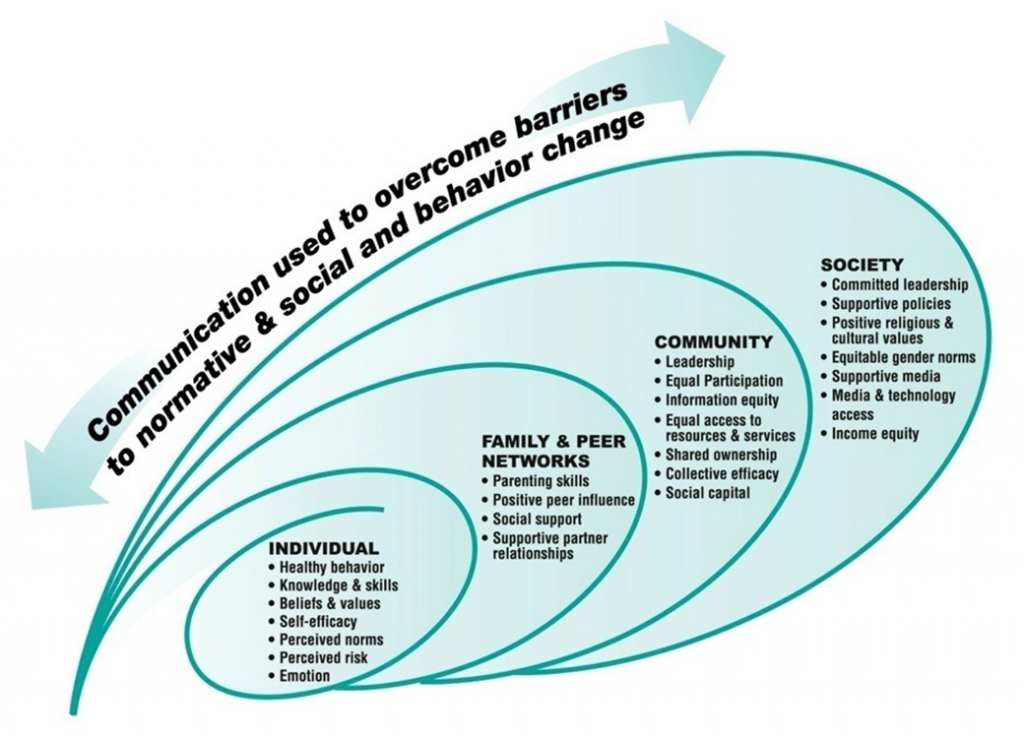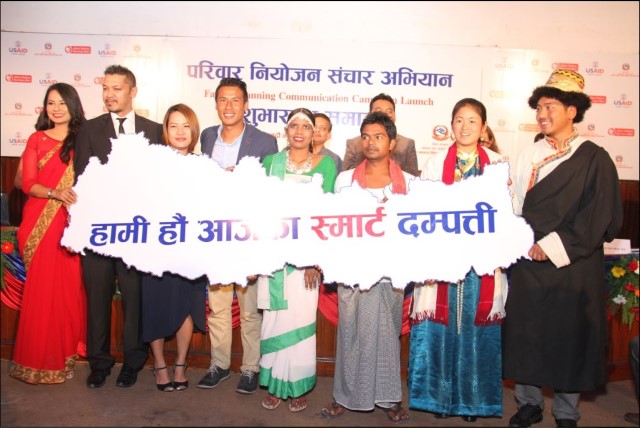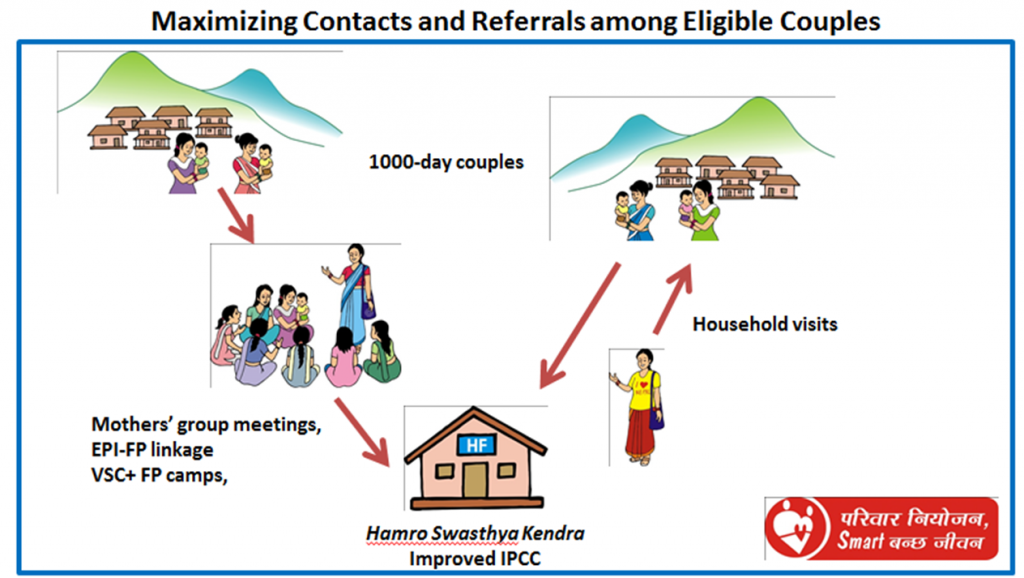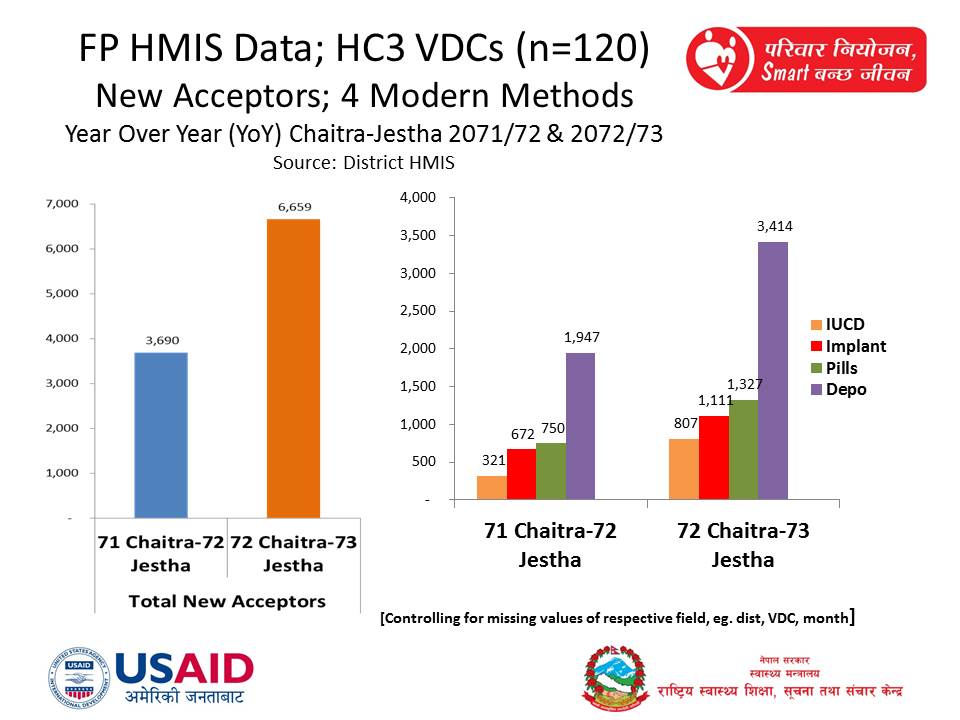In Nepal, the Health Communication Capacity Collaborative (HC3) is working to increase access to modern contraceptives among couples across the country. The Next Generation “Smart Couple” Family Planning Campaign focuses on young, low-parity Nepali couples (those with one or two children) using a multi-channel approach, with high-quality television and radio spots, as well as the use of other media.
The campaign was carried out in coordination with the Ministry of Health and Population and the Nepal National Health Education Information and Communication Center. The aim is to increase access to modern contraceptives among young married couples, including both the newly married and “1000 day couples.” 1000 days denotes the time from pregnancy until a child is two years old.
In describing the vision and positioning of the family planning campaign, Ron Hess, Project Director of HC3 in Nepal, says, “Family planning is a means to an end. We must start by asking, ‘Why family planning?’ People here give many reasons why they want to manage their number of children: to provide them with better care and nurturing, a better home and, very importantly, a better education. In short, parents in Nepal want a brighter future for their children, as parents do the world over. The current campaign respects these aspirations – placing the ‘why’ of family planning first, then offering family planning solutions as ‘smart’ means toward these ends.”
Timeline
UPDATE!
In May 2017, the program won the prestigious Flame Award (Gold), recognizing it as the best Social Development and Corporate Social Responsibility campaign of 2017 in the Emerging Markets/South Asia category in the competition.
The award for the national family planning campaign was announced at an April 28, 2017 event of the Rural Marketing Association of India (RMAI) in New Delhi. Campaigns from across South Asia – Bangladesh, Sri Lanka, India, and Nepal – competed for the award in the social development sector/improving health and empowerment in rural areas of South Asia.

Banner photo: Mothers with their children in Nepal. © 2013 Valerie Caldas/ Johns Hopkins University Center for Communication Programs, Courtesy of Photoshare
Inquire
While gains in family planning (FP) have been made among certain segments of the population, it is still true that the segments including young and newly married Nepali couples, those wishing to limit childbirth, and those in need of birth spacing are lagging behind.
According to the Nepal Demographic and Health Survey (2011):
- 56 percent of women of reproductive age are below 30 years of age
- For women and couples under 30:
- Only 12 percent use FP to delay the birth of their first child
- Fewer than 32 percent use FP to space their second child after the first birth
- Fewer than 13 percent are using FP within two months after delivery
Contraceptive prevalence stagnated at 44% between 2006 and 2011 and the total fertility rate declined from 3.1 in 2006 to 2.6 in 2011. There was found to be a high unmet need for FP among migrants, married adolescents, and social excluded groups. This resulted in many missed opportunities for promoting uptake of modern FP. One of the Millenium Development Goals for Nepal was a contraceptive prevalence rate (CPR) of 67% by 2015.


To inform the project design, the HC3 team conducted formative research consisting of sixty in-depth interviews exploring attitudes, norms, experiences and processes that influence contraceptive use.
Participants included:
- Unmarried women and men
- Married women and men
- Mothers-in-law
- Migrants
- Health workers and Female Community Health Volunteers (FCHVs)
- Influential community members
Major highlights from the formative research included:
- Couples report using FP at distinct stages in their lives
- Fertility management is placed within the larger context of other parental care roles and practices
- Fertility management is typically a cooperative decision between the couple
- FP is related to shared goals for family and future
Design the Strategy
The strategic objective of the Smart Couple campaign is to: Increase modern contraceptive use among “1000-day couples and newlyweds”, or young, low-parity women and men, specifically:
- Increase age of first birth
- Improve timing of FP use after delivery
- Increase optimal birth-spacing practices
- Increase long-term method use
- Reduce unmet need among marginalized and disadvantaged groups
- Improve contraceptive use dynamics among migrants (timing of initiation, discontinuation)
The strategy for the Smart Couple campaign was designed using the social-ecological model of behavior change, seen below.

The campaign approach is to:
- Reposition FP as the smart, healthy choice allowing couples to achieve success for themselves and their children
- Be aspirational, encouraging a better life based on smarter life choices
- Institute a brand to guide the program and to tie all aspects together visually and thematically
The campaign’s life-stage approach is illustrated below:

The strategy’s action plan is to encourage couples to:
- Establish early FP behaviors to delay first birth
- Avoid unintended postpartum pregnancy
- Space births successfully
- Encourage couples to know the facts about FP
- Encourage action NOW
This will not only help to improve maternal and child health outcomes in the short term, but will establish FP use as a behavioral norm and, thus, affect longer-term fertility trends. The campaign, through its community programs in the districts, also focuses on families of migrant workers and people from marginalized and disadvantaged communities.
Create and Test
Pretesting found the word “Smart” had become a familiar term in Nepal, which was associated with new technology. Additionally, “Smart Couple” is associated with the concept of mutual understanding, along with a bright and intelligent future.
Consequently, the “Smart Couple” campaign seeks to encourage modern contraceptive use earlier among young couples, as well as to increase spacing between the first and second child by using a family planning method postpartum.
- Smart Couple Nepal Campaign Word Testing Report
- Smart Couple Nepal Campaign Wave II Materials Pre-test Report
- Smart Couple Nepal campaign Wave-II TVCs, Badhai Booklet and IPCC modules pre-testing report
- Smart Couple Nepal Press Release
- Smart Couple Nepal Family Planning TV Spots
- Smart Couple Nepal Family Planning Posters
- Smart Couple Nepal Booklets/Brochures
- Smart Couple Nepal Badhai Booklet
- Smart Couple Nepal Advocacy Brochure
- Smart Couple Nepal Campaign Pamphlet, Poster Pretesting Report
- Radio Spots – Nepal Earthquake Recovery
- Suaahara SBCC Strategy: Earthquake Emergency Initial Recovery Period
- Suaahara Earthquake Health Awareness Poster
- Earthquake Emergency Special Hello Bhanchhin Aama Radio Program
- Post-Earthquake Communications Plan
- Nepal IPCC Modules Comic Book
- Nepal Earthquake Materials
Mobilize and Monitor
The launch of the Smart Couple campaign, on August 21, 2015 was a high profile event. It included speeches by the Health Education Minister, Ministry of Public Health, the Secretary of Public Health, the Director General of the Department of Health, and the USAID Mission director, among others.
The event was hosted by a celebrity couple, Malvika & Riaz (Ms. Nepal and her husband, a dance instructor), and there were 175 attendees. The event was telecast live by Nepal TV, and there was national press coverage.

In addition, the campaign was active on Twitter, Facebook, and YouTube.
In order to maintain the momentum, on Valentines Day – February 14, 2016 – the campaign announced a Facebook contest – asking couples to write on the Facebook page that they agreed to commit to using FP and upload a photo of themselves. Out of the 2,400 submissions, 10 winners were chosen.

District Campaigns and Activities
The HC3 Nepal project is systematically contacting and referring “1000-Day” couples in order to maximize communication with the couples, increase referrals to health centers and enhance service provider counseling.
The activities utilized the District Model (below) and included:
- An expanded immunization/outreach clinics program
- Mothers group meetings
- Household visits
- Systematically contacting and referring “1000-Day” couples:
- Improved IPC-Counseling at Hamro Swasthya Kendra (HFs)
- Active FP service promotion
- Regional, large-scale “Smart Couple” PR events
- Local “Smart Couple” Celebration events
- Street dramas, community school programs
- Local FM Radio airing of Smart Couple campaign spots, Radio Help Desk
- Continuous coordination with District Health Offices, District Project Advisory Committees, Reproductive Health Coordination Committees, Health Facility Operations and Management Committees, etc.
The district model:

Regional Activities
Regional events were also held -these were called Regional “Smart Jeewan [Couple]” melas, or events, and included leadership support; celebrity ‘infotainment,’ and a family-friendly atmosphere. Attendance was impressive, and all were broadcast live:
- Western Region (Kaski): ~5000
- Central Region (Chitwan): ~10,000
- Midwestern (Nepalganj): ~20,000
- Far Western (Kanchanpur): ~30,000

Using an infotainment approach to build support for FP and the Smart Couple campaign, the events also attracted an estimated 300,000 viewers of the live telecast of the event. During both events, the popular sit-com Bhadragol team enacted the life stage approach of Smart Couple with family planning. In Banke, popular singer Sugam Pokharel also spread the message of the Smart Couple to the audience. In Kanchanpur, Sugam Pokharel and Shiva Pariyar promoted the concept.
Evaluate and Evolve
A forthcoming end-line evaluation will assess the impact of the project. This Spotlight page will be updated as the project completes impact results studies.
The social media results (social media coverage began October 18, 2015):
- Total FB users – 5,800,000
- Total Smart Couple page reach in Facebook – 5,617,095 (repeated)
- Smart Dampati (Smart Couple) FB Campaign ad reach – 807,100
- Newly married video reach – 558,700
- Festival greeting video – 297,900
- Sugam Pokharel’s performance during launch of app – 7,100
- Users of Smart Dampati App – 6,031
- Successful upload of photos – 2,115
Nationwide, in 13 focal districts, the campaign was found to have reached 58% of adults (Source: Sharecast Survey, Sharecast Initiative of Nepal, Dec 2015)
The campaign also resulted in an increase in client contacts and referrals (see charts below – clilck on the chart to see it larger).


| Through the campaign and its anthem, “Hami haun ajaka Smart ,” (“We are today’s smart couples”), family planning is on its way to becoming the ‘new normal’ for young couples in Nepal.Campaign Asia Pacific, May 2016 |
Lessons Learned
Below are a few of the lessons learned through the implementation of this campaign:
- An analysis of the data shows that a national SBCC program implemented at scale is needed to obtain national results, especially among the youth marrieds/young family cohort, who have very high unmet need and are dispersed throughout the country and throughout all caste and ethnic groups.
- Focused district programs are needed to reach disadvantaged groups with highest unmet need and who are geographically concentrated. Interventions to reach these populations must be local. To be cost-effective, HC3 is implementing a program of systematic contacts of eligible men and women with referrals to quality-improved health facilities.
- Distributed capacity among all partners is needed for sustainability; It is crucial to inter-link, coordinate, collaborate with other stakeholders to build synergy and distributed capacity.
- Obtaining government buy-in at all levels (national, regional, district, VDC) for all stages of program establishment, key staffing, activities initiation, endorsement requires intensive coordination and time. However with government buy-in established and close coordination at all levels, the activities receive the needed support and attention to be successfully carried out.
Prizes and Recognition
In May 2017, the program won the prestigious Flame Award (Gold), recognizing it as the best Social Development and Corporate Social Responsibility campaign of 2017 in the Emerging Markets/South Asia category in the competition.
The award for the national family planning campaign was announced at an April 28, 2017 event of the Rural Marketing Association of India (RMAI) in New Delhi. Campaigns from across South Asia – Bangladesh, Sri Lanka, India, and Nepal – competed for the award in the social development sector/improving health and empowerment in rural areas of South Asia.

Date of Publication: April 20, 2022



